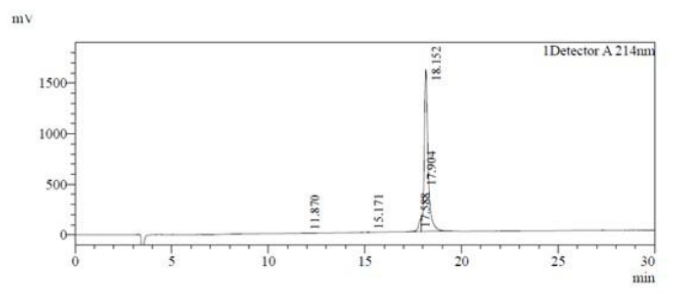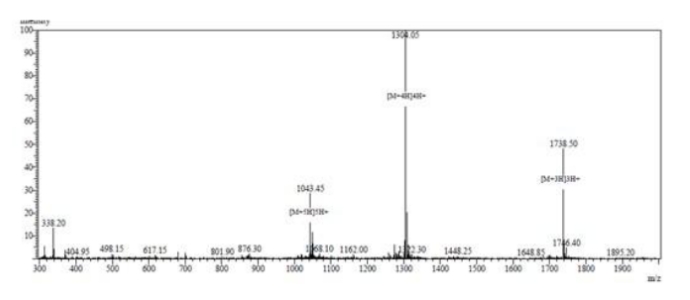-
-
ABOUT US

-

-

SERVICE
SERVICE
Custom peptide
1. Isotope Labeling
Labeling types: 13C/15N full labeling, deuteration (2H), site-specific isotopes (Lys/Arg, etc.)
Inventory coverage: 15 kinds of stable isotope-labeled amino acids in stock (e.g., 13C6-Arg, 15N2-Lys, D10-Leu)
Technical highlights: Stable isotope labeling technology, enabling multiple isotope labeling
2. Fluorescent Labeling
Dye library: CY3/CY5/CY5.5/CY7, FITC, FAM, TAMRA series
Labeling strategy: N-terminal/C-terminal site-specific labeling
Technical highlights: >90% labeling efficiency
|
Fluorescent dye |
Characteristics |
Color |
Excitation wavelength (nm) |
Emission wavelength (nm) |
|
CY3 |
High fluorescence intensity, good photostability, good cell permeability, suitable for various biological experiment labeling |
Orange-red |
550 |
570 |
|
CY5 |
Near-infrared fluorescence, strong tissue penetration, strong fluorescence signal, low background interference, often used in in vivo imaging |
Red |
649 |
670 |
|
CY5.5 |
Longer excitation and emission wavelengths, more suitable for deep tissue imaging, good light and chemical stability |
Deep red |
675 |
700 |
|
CY7 |
Near-infrared fluorescence, strong tissue penetration, high fluorescence quantum yield, high detection sensitivity |
Near-infrared |
750 |
773 |
|
FITC |
High fluorescence quantum yield, chemically active, can covalently bind to a variety of biomolecules |
Green |
495 |
520 - 530 |
|
FAM |
Good water solubility and stability, often used for nucleic acid labeling, excitation and emission wavelengths are similar to FITC |
Green |
494 |
520 |
|
TAMRA |
Good photostability, high fluorescence intensity, often used as a FRET acceptor dye |
Orange |
555 |
580 |
3. Biotinylation
Technical highlights: Significantly improves detection sensitivity, HPLC purity >98%, can also be combined with fluorescent labeling (such as CY5), isotope labeling (such as 13C), polyethylene glycol (PEG), etc.
4. Protein Conjugation
Carrier protein: KLH (strong immunogenicity), BSA (excellent stability), OVA (commonly used in animal experiments)
Conjugation methods: Glutaraldehyde crosslinking, SMCC chemical conjugation, NHS ester directional linking
5. PEGylation
PEG molecular weight: 2kDa-40kDa (linear/branched optional)
Modification site: N-terminal, C-terminal or Lys side chain site-specific modification
6. Post-translational Modification Mimicry (PTM Mimicry)
|
Modification type |
Technical description |
|
Lactylation |
Lys site-specific lactic acid group introduction |
|
Methylation |
Lys/Arg site mono/di/trimethylation |
|
Phosphorylation |
Ser/Thr/Tyr phosphorylation |
|
Sulfation |
Tyr sulfation (simulating natural heparin binding site) |
We provide high-quality peptides with two, three, four, and five phosphorylation sites. With mature synthesis and purification technology and a constantly striving elite team, Gu Bio has become a trustworthy peptide supply Brand.
Successful cases:
Sequence NH2-TERD(pS)D(PT)DVEEDSRPPGRPAEVHLERAQPFGFID(pS)D(pS)DAEEEYCONH2, four phosphorylation modification sites.
HPLC analysis:

MS analysis:

COOKIES
Our website uses cookies and similar technologies to personalize the advertising shown to you and to help you get the best experience on our website. For more information, see our Privacy & Cookie Policy
COOKIES
Our website uses cookies and similar technologies to personalize the advertising shown to you and to help you get the best experience on our website. For more information, see our Privacy & Cookie Policy
These cookies are necessary for basic functions such as payment. Standard cookies cannot be turned off and do not store any of your information.
These cookies collect information, such as how many people are using our site or which pages are popular, to help us improve the customer experience. Turning these cookies off will mean we can't collect information to improve your experience.
These cookies enable the website to provide enhanced functionality and personalization. They may be set by us or by third-party providers whose services we have added to our pages. If you do not allow these cookies, some or all of these services may not function properly.
These cookies help us understand what you are interested in so that we can show you relevant advertising on other websites. Turning these cookies off will mean we are unable to show you any personalized advertising.
Address: Model B204, B205-1, Hi-tech Capital City High-end Equipment Incubation Base, No. 23, Hangbu Road, Baiyan Science Park, Hi-Tech Zone, Hefei City
Sales Tel: 19856166839; 15705607678; 17354056623
Fax: 0551-62869631
E-mail: sales@bankpeptide.com





